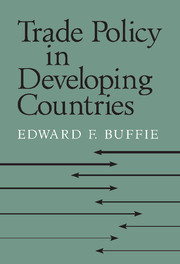Book contents
- Frontmatter
- Contents
- 1 Introduction
- 2 Tools and Tricks of the Trade, Part I: Duality Theory
- 3 The Trade Policy Debate
- 4 Tools and Tricks of the Trade, Part II: Linear Differential Equations and Dynamic Optimization
- 5 Underemployment, Underinvestment, and Optimal Trade Policy
- 6 Liberalization and the Transition Problem, Part I: Transitory Unemployment
- 7 Tools and Tricks of the Trade, Part III: The Dynamics of Temporary Shocks
- 8 Liberalization and the Transition Problem, Part II: Credibility and the Balance of Payments
- 9 Direct Foreign Investment, Economic Development, and Welfare
- 10 Suggestions for Future Research
- References
- Index
3 - The Trade Policy Debate
Published online by Cambridge University Press: 29 July 2009
- Frontmatter
- Contents
- 1 Introduction
- 2 Tools and Tricks of the Trade, Part I: Duality Theory
- 3 The Trade Policy Debate
- 4 Tools and Tricks of the Trade, Part II: Linear Differential Equations and Dynamic Optimization
- 5 Underemployment, Underinvestment, and Optimal Trade Policy
- 6 Liberalization and the Transition Problem, Part I: Transitory Unemployment
- 7 Tools and Tricks of the Trade, Part III: The Dynamics of Temporary Shocks
- 8 Liberalization and the Transition Problem, Part II: Credibility and the Balance of Payments
- 9 Direct Foreign Investment, Economic Development, and Welfare
- 10 Suggestions for Future Research
- References
- Index
Summary
In this chapter I try to provide a balanced, dispassionate critique of the various arguments that have been advanced for export promotion and against protection. The chapter begins with a brief overview of LDC trade policy that introduces some basic concepts and discusses the main features of import-substituting industrialization (ISI). Following this, Section 3.2 examines at length the argument that the first-best remedy for most types of market failure is to combine free trade with an appropriate tax or subsidy. The argument is powerful but subject to the qualifications that the most direct tax/subsidy intervention (i) not involve greater administrative costs than the comparable trade tax, and (ii) not adversely affect the strategic environment in which policy makers operate. If these qualifications matter, trade taxes may have a place in the optimal policy package.
The second half of the chapter deals with more specific aspects of the policy debate. Section 3.3.1 appraises the infant industry argument, the oldest and most common defense of protection. In Section 3.3.2, I discuss the nature of factor market distortions in LDCs and the claim that ISI exacerbates the underemployment problem. Sections 3.3.3 and 3.3.4 examine the theory and empirical evidence bearing on the connection between trade policy, production and prices in oligopolistic markets, scale economies, and productivity growth.
- Type
- Chapter
- Information
- Trade Policy in Developing Countries , pp. 30 - 97Publisher: Cambridge University PressPrint publication year: 2001

